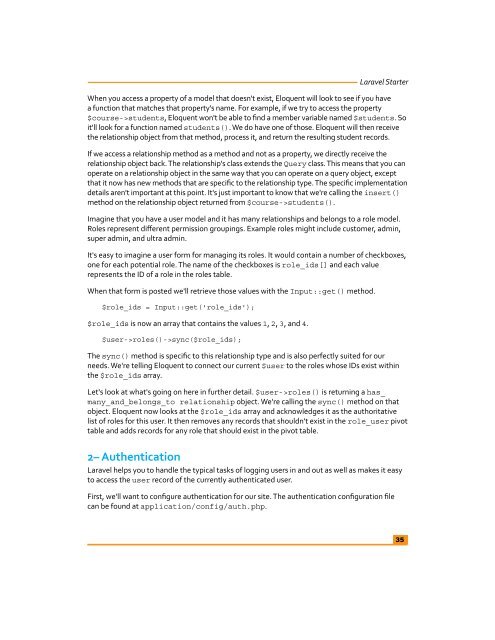Laravel Starter - PHP User Group (Myanmar)
Laravel Starter - PHP User Group (Myanmar)
Laravel Starter - PHP User Group (Myanmar)
Create successful ePaper yourself
Turn your PDF publications into a flip-book with our unique Google optimized e-Paper software.
<strong>Laravel</strong> <strong>Starter</strong><br />
When you access a property of a model that doesn't exist, Eloquent will look to see if you have<br />
a function that matches that property's name. For example, if we try to access the property<br />
$course->students, Eloquent won't be able to find a member variable named $students. So<br />
it'll look for a function named students(). We do have one of those. Eloquent will then receive<br />
the relationship object from that method, process it, and return the resulting student records.<br />
If we access a relationship method as a method and not as a property, we directly receive the<br />
relationship object back. The relationship's class extends the Query class. This means that you can<br />
operate on a relationship object in the same way that you can operate on a query object, except<br />
that it now has new methods that are specific to the relationship type. The specific implementation<br />
details aren't important at this point. It's just important to know that we're calling the insert()<br />
method on the relationship object returned from $course->students().<br />
Imagine that you have a user model and it has many relationships and belongs to a role model.<br />
Roles represent different permission groupings. Example roles might include customer, admin,<br />
super admin, and ultra admin.<br />
It's easy to imagine a user form for managing its roles. It would contain a number of checkboxes,<br />
one for each potential role. The name of the checkboxes is role_ids[] and each value<br />
represents the ID of a role in the roles table.<br />
When that form is posted we'll retrieve those values with the Input::get() method.<br />
$role_ids = Input::get('role_ids');<br />
$role_ids is now an array that contains the values 1, 2, 3, and 4.<br />
$user->roles()->sync($role_ids);<br />
The sync() method is specific to this relationship type and is also perfectly suited for our<br />
needs. We're telling Eloquent to connect our current $user to the roles whose IDs exist within<br />
the $role_ids array.<br />
Let's look at what's going on here in further detail. $user->roles() is returning a has_<br />
many_and_belongs_to relationship object. We're calling the sync() method on that<br />
object. Eloquent now looks at the $role_ids array and acknowledges it as the authoritative<br />
list of roles for this user. It then removes any records that shouldn't exist in the role_user pivot<br />
table and adds records for any role that should exist in the pivot table.<br />
2– Authentication<br />
<strong>Laravel</strong> helps you to handle the typical tasks of logging users in and out as well as makes it easy<br />
to access the user record of the currently authenticated user.<br />
First, we'll want to configure authentication for our site. The authentication configuration file<br />
can be found at application/config/auth.php.<br />
35




